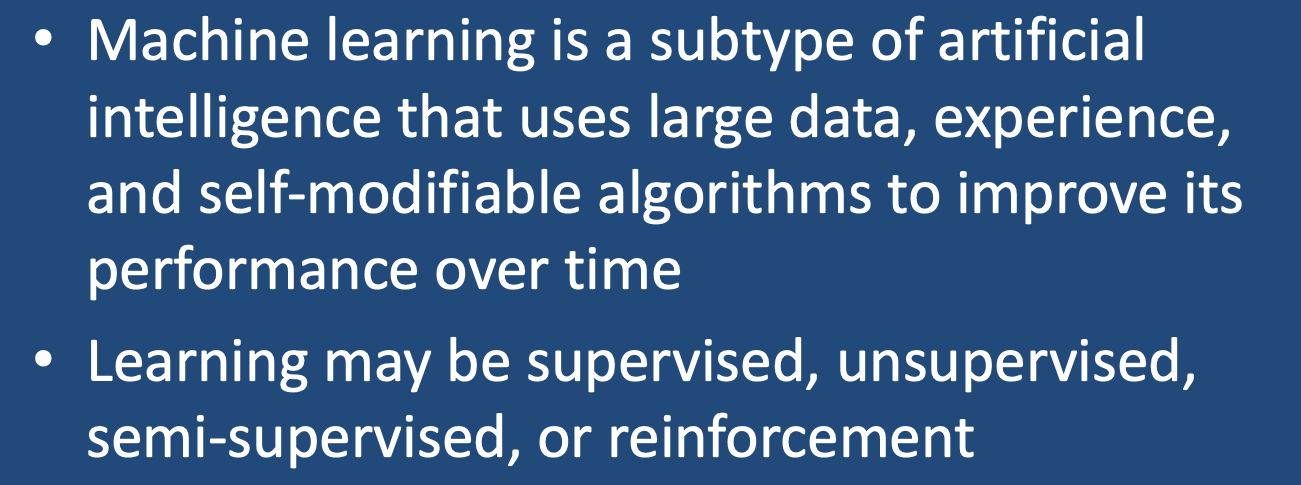|
No. Machine learning (ML) is a subset of artificial intelligence (AI). Therefore, all ML is AI, but not all AI is ML. What makes ML unique is that that machine learning systems can actually reprogram themselves. They employ self-modifiable algorithms that improve automatically over time through training and the use of data. They can carry out tasks without being explicitly programmed to do so. In brief, they actually learn from experience! Today the most important type of ML relevant to MRI is known as deep learning (DL), the subject of its own Q&A.
But how do machines learn? More details will be presented in later Q&A's, but machine learning typically takes place using one of five methods: |
- Supervised learning is the most widely used form of ML for radiological applications today. In this method, the computer system is provided with data sets (commonly images) that bear a known label (e.g., benign or malignant) established by an external authority (e.g., a panel of experts). These labels serve as a gold standard or ground truth by which the successful performance of the network will be assessed. Most of the labeled data sets will be used for training; a small number will be retained for final validation. During training, the algorithm attempts to classify the inputs, and its accuracy is compared to the table of ground truths. A loss function (or error score) is calculated. Weighting factors and parameters of the network are then modified in an iterative fashion to minimize the loss. After the algorithm has been optimized, its performance on a validation set of different cases with known labels is evaluated. The process is considerably more complicated than the paragraph above reveals, and these steps will be further elucidated in several subsequent Q&A's.
- In unsupervised learning the computer system is given a training set of data (e.g. tumor images) but without labels. It must then separate those images into groups based on extracted features (e.g., distribution of T2 values, size, edge characteristics). Popular techniques include self-organizing maps, k-means clustering, nearest-neighbor mapping, and singular value decomposition. Currently the most common use of unsupervised learning in medical imaging is to discover hidden structures within the training data.
- In semi-supervised learning only a small portion of the training set is labeled. The computer system then uses the unlabeled data to try to improve the classification of these data in a manner similar to unsupervised learning. Semi-supervised learning is often employed when a complete training set of fully labeled data is too expensive or difficult to acquire.
- Reinforcement learning is often used for natural language processing, robotics, and navigation applications. By trial and error the algorithm discovers which actions yield the greatest rewards (successful outcomes) over the shortest period of time. The popular Chat-GPT was optimized for dialogue by using Reinforcement Learning with Human Feedback (RLHF) to guide the model toward human-like behavior.
- In transfer learning a model trained on one task is re-purposed and applied to a second related task. For example, a network previously optimized to identify human faces might be used as the first step to jumpstart an algorithm learning to segment a brain MRI.
Advanced Discussion (show/hide)»
No supplementary material yet. Check back soon!
References
Erickson BJ, Korfiatis, P, Akkus Z, Kline TL. Machine learning for medical imaging. RadioGraphics 2017; 37:505-515. [DOI LINK]
European Society of Radiology. What the radiologist should know about artificial intelligence - an ESR white paper. Insights into Imaging 2019;1:44.
Google Developers. Machine learning glossary. (Downloaded from https://ai.google/education 28 July 2022).
Nicholson C. AI and machine learning glossary. In: A.I. Wiki. A beginner’s guide to important topics in AI, machine learning, and deep learning. (Downloaded from wiki.pathmind.com/glossary 13 Jan 2022)
Nicholson C. A beginner’s guide to neural networks and deep learning. In: A.I. Wiki. A beginner’s guide to important topics in AI, machine learning, and deep learning. (Downloaded from wiki.pathmind.com 13 Jan 2022)
Nicholson C. Reinforcement learning definitions. In: A.I. Wiki. A beginner’s guide to important topics in AI, machine learning, and deep learning. (Downloaded from wiki.pathmind.com 13 Jan 2022)
Erickson BJ, Korfiatis, P, Akkus Z, Kline TL. Machine learning for medical imaging. RadioGraphics 2017; 37:505-515. [DOI LINK]
European Society of Radiology. What the radiologist should know about artificial intelligence - an ESR white paper. Insights into Imaging 2019;1:44.
Google Developers. Machine learning glossary. (Downloaded from https://ai.google/education 28 July 2022).
Nicholson C. AI and machine learning glossary. In: A.I. Wiki. A beginner’s guide to important topics in AI, machine learning, and deep learning. (Downloaded from wiki.pathmind.com/glossary 13 Jan 2022)
Nicholson C. A beginner’s guide to neural networks and deep learning. In: A.I. Wiki. A beginner’s guide to important topics in AI, machine learning, and deep learning. (Downloaded from wiki.pathmind.com 13 Jan 2022)
Nicholson C. Reinforcement learning definitions. In: A.I. Wiki. A beginner’s guide to important topics in AI, machine learning, and deep learning. (Downloaded from wiki.pathmind.com 13 Jan 2022)
Related Questions
What is artificial intelligence (AI)?
Is deep learning (DL) the same as machine learning (ML)?
I still don't understand how machines learn. How do they "reprogram" themselves?
What is artificial intelligence (AI)?
Is deep learning (DL) the same as machine learning (ML)?
I still don't understand how machines learn. How do they "reprogram" themselves?

